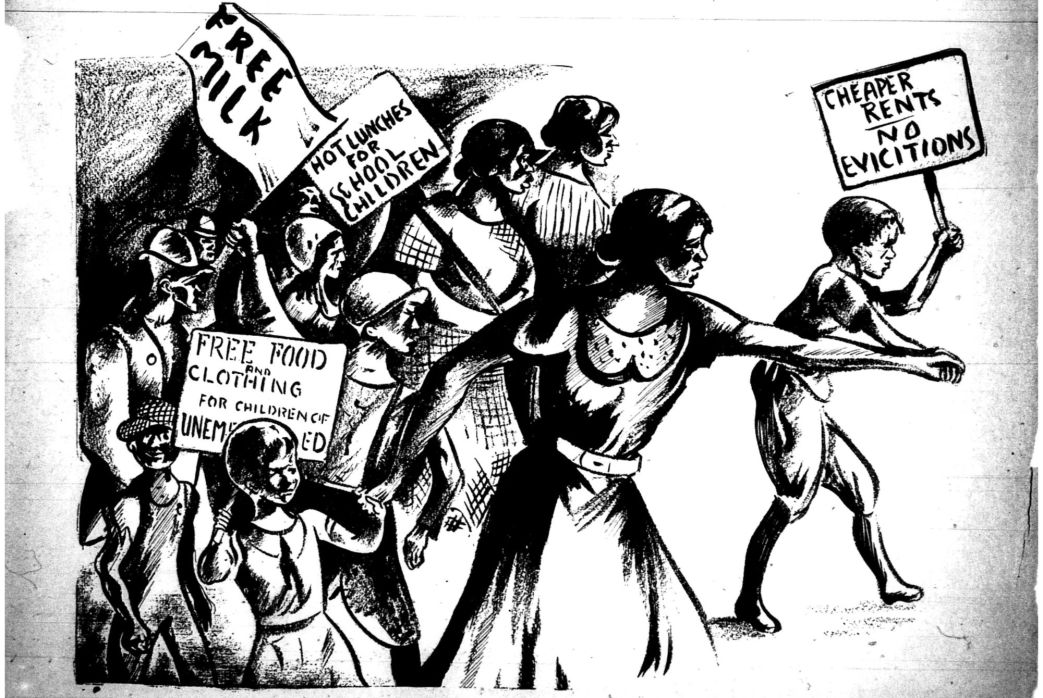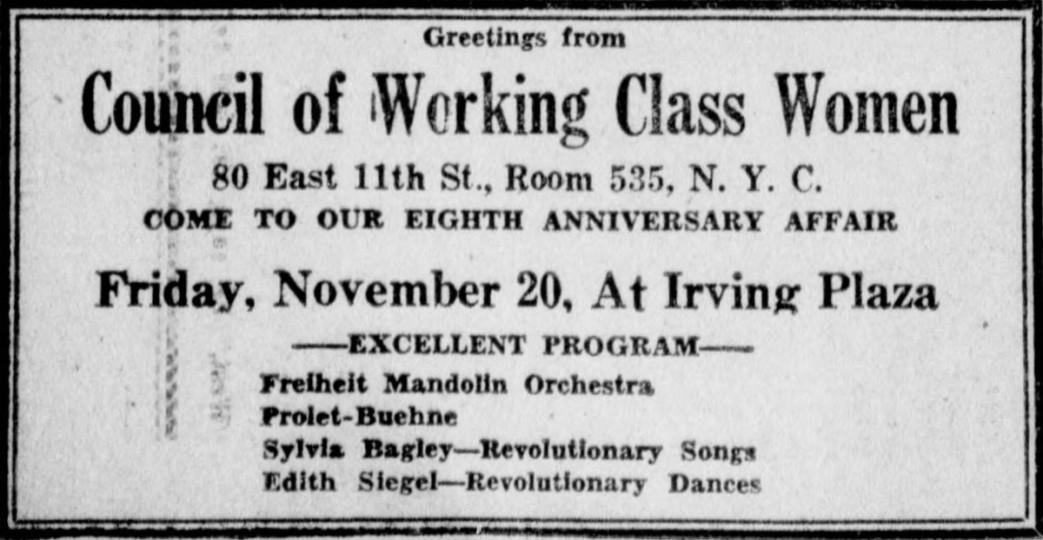The U.S. Communist movement in its first decades had very few women-specific ‘mass organizations.’ The most successful project was the United Council of Working Class Women (renamed Progressive Women’s Councils with the Popular Front in 1935) founded in 1923 under the leadership of Kate Gitlow. Reborn in 1929 with the leadership of Clara Lemlich and Rose Nelson, here is a report recording their growth in New York as the crisis of the 1930s began to take hold.
‘N.Y. Council of Working Class Women In Activities’ from Working Woman. Vol. 2 No. 12. December, 1931.
Fight Against High Living Costs; Aid Build Unemployed and Children’s Movement
NEW YORK. The United Council of Working Class Women is now taking on a new orientation. For the last eight months the major activities of the councils have been the development of local issues, such as section strikes against the high cost of living, the fight for the lowering of rents, school problems, etc.
During the last two months five new councils have been added, making a total of forty-eight. At present we are engaged in a three months’ membership drive. The goal is five hundred new members, to be recruited from the real proletarian districts; with the main aim to draw into the organization. Negro women, native born, and other language working class women. The main concentration points are Harlem and downtown also other sections in New York and vicinity are being penetrated into.
Councils Are Active
Due to the new phase of work, the councils are bubbling with life. Where, only six months ago, the councils would hesitate in holding open air meetings, due to the lack of speakers, at present open air meetings are held weekly throughout the city, with speakers springing from the ranks of the local councils.
The attitude is no more theoretical speeches. The issues of the present time, such as unemployment, the high cost of living, increased gas and electricity rates, etc., are problems faced by every working class housewife. Is it a wonder that the council members can conduct meetings with their own forces?
As a result of this new members are coming in by leaps and bounds. Since October 15, when the membership drive was officially started, about one hundred and fifty new members joined the organization.

At present the Coney Island and Brighton Councils are becoming involved in a struggle for far cheaper bread. The sentiment for a strike is high. Open air meetings are held daily. Leaflet distribution from house to house is being carried on. Indoor meetings are being held with the workers of the neighborhood attending.
The councils, in order to be able to carry on the work systematically, are carrying through a well prepared educational program. The purpose of this is to train the comrades both organizationally and politically.
Classes in English are organized with capable instructors. Discussions are held on timely topics, led by council members in the various councils. Lectures on important working class problems, to which outsiders are drawn in, are held. Later on the new contacts are drawn into the organization. Correspondence circles are gradually springing up. Articles are written on everyday experiences and wall papers are made up. Circulation libraries are being established, with the latest pamphlets, and books at the disposal of the comrades. The councils issue a monthly bulletin, “The Voice of the Councils.”
Building Children’s Movement
The councils are playing an important part in the building of the Pioneer movement, to help rally the workers’ children behind their interests. The councils will participate in the hunger march to Washington, with five delegates. They are also raising funds for the Hunger March by collections on tag days and through coupon books.
The councils will be a factor in helping to build the unemployment councils, through moral and financial assistance. The councils are involved in the drive to help establish milk stations for children of the unemployed. The councils are fighting for free food and for free clothing for children of the unemployed, etc.
The Council of Working Class Women calls upon all workers’ wives to join its ranks, to help carry on the struggle against the high cost of living, against high rents, against imperialist war; for the defense of the Soviet Union, the only country where the workers and peasants rule.
For lower food prices.
For lower rent and better housing.
For more and better schools in the working class neighborhoods.
For reduced gas and electricity rates.
For free food and clothing for children of the unemployed.
For pure and cheaper milk.
Organize a council in every working class neighborhood.
The Working Woman, ‘A Paper for Working Women, Farm Women, and Working-Class Housewives,’ was first published monthly by the Communist Party USA Central Committee Women’s Department from 1929 to 1935, continuing until 1937. It was the first official English-language paper of a Socialist or Communist Party specifically for women (there had been many independent such papers). At first a newspaper and very much an exponent of ‘Third Period’ politics, it played particular attention to Black women, long invisible in the left press. In addition, the magazine covered home-life, women’s health and women’s history, trade union and unemployment struggles, Party activities, as well poems and short stories. The newspaper became a magazine in 1933, and in late 1935 it was folded into The Woman Today which sought to compete with bourgeois women’s magazines in the Popular Front era. The Woman today published until 1937. During its run editors included Isobel Walker Soule, Elinor Curtis, and Margaret Cowl among others.
PDF of full issue: https://www.marxists.org/history/usa/pubs/wt/v2n12-dec-1931-WW-R7414.pdf

